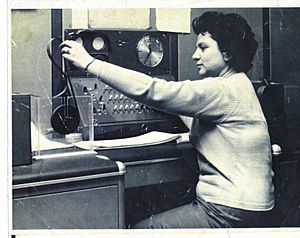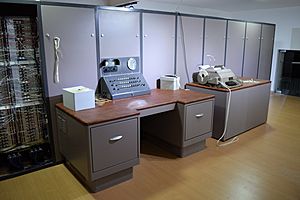Cecilia Berdichevsky facts for kids
Quick facts for kids
Cecilia Berdichevsky
|
|
|---|---|

Berdichevsky with the Mercury computer, named Clementina
|
|
| Born |
Cecilia Tuwjasz
30 March 1925 Vilnius, Lithuania-Poland
|
| Died | 28 February 2010 Avellaneda, Argentina
|
| Nationality | Argentinian |
| Other names | Cecilia Berdichevski |
| Occupation | computer scientist |
| Known for | Work on Ferranti Mercury |
| Spouse(s) | Mario Berdichevsky |
Cecilia Berdichevsky (born Cecilia Tuwjasz) was a very important Argentinian computer scientist. She was a pioneer in the field, meaning she was one of the first people to work with computers in her country. Her work began in 1961 with Argentina's first Ferranti Mercury computer.
Contents
Early Life and Education
Cecilia Tuwjasz was born on March 30, 1925, in Vilnius. This city is now the capital of Lithuania. At that time, it was part of Poland.
When Cecilia was five years old, her family moved to Argentina. They left their home because of difficult times for Jewish people in their country. Cecilia grew up in Avellaneda, a city near Buenos Aires. Her father passed away a few years after they arrived in Argentina. Her mother later remarried.
In 1951, Cecilia married Mario Berdichevsky. He was a doctor from Avellaneda. Cecilia worked as an accountant for ten years. But she wasn't happy with her job. A friend, who was also a computer scientist named Rebeca Guber, encouraged her to go back to school. This decision changed Cecilia's life.
Working with Clementina
At age 31, Cecilia Berdichevsky started studying mathematics. She went to the University of Buenos Aires. There, she met Manuel Sadosky, who became her mentor. This is where she first learned to program computers.
She worked with a new computer called the Ferranti Mercury. People nicknamed it "Clementina." This happened after someone programmed it to play the song "My Darling Clementine."
In 1961, Clementina arrived in Buenos Aires from England. It was the most powerful computer in Argentina at the time. It cost $300,000 and was about 18 meters (59 feet) long! Clementina was the first large computer used for science in Argentina. Another computer, an IBM 1401, was installed that same year for business use.
Cecilia learned about computing from visiting experts. One was an English software engineer named Cicely Popplewell. She was famous for working with Alan Turing in Manchester. Another expert was the Spanish mathematician Ernesto García Camarero.
Cicely Popplewell encouraged Cecilia to write the first program for Clementina. This program needed many math calculations. To put information into the computer, a special device read a paper ribbon with holes punched in it. Clementina then gave the correct answer in just a few seconds.
In 1962, Cecilia was one of two people who won scholarships. These scholarships allowed them to study computers further. She spent five months at the University of London and then five months at a French institution. She returned home the next year as an expert on Clementina.
Cecilia explained how Clementina worked. She said it could only do one thing at a time. It could do three basic math operations: adding, subtracting, and multiplying. The computer used special computer languages. These included machine language and an assembler called Pig2. It also used a high-level programming language called Autocode. Later, another language called Comic replaced Autocode. Back then, these languages were made only for one type of computer. They couldn't be used on many different computers until much later.
Cecilia also worked as the Head of Practical Works for a math course. Her mentor, Manuel Sadosky, was the main professor for this course. He was also the vice-dean of the Faculty of Exact Sciences at the University of Buenos Aires.
Political Changes in Argentina
Cecilia worked with Sadosky's institute until 1966. That year, a military group took control of the Argentinian government. This is called a coup d'état. The new military government tried to control the universities. Before this, universities were mostly independent.
This caused protests from students and professors. On July 29, 1966, there was a violent event called the Night of the Long Batons. Military troops beat and removed the academic people from the University of Buenos Aires. Many academics, including Sadosky, were forced to leave the country.
After this, Cecilia Berdichevsky started working as an accountant again. From 1966 to 1970, she was also a director at Scientific Technical Advisors (ACT). This company was started by her former colleagues, Manuel Sadosky, Rebeca Guber, and Juan Chamero.
Later Career and Retirement
In 1984, Cecilia became an important manager at the Argentine savings bank, Caja de Ahorro. She was in charge of its computer center. She also became a representative for an important international computer group called the International Federation for Information Processing.
After she retired, Cecilia continued to work as a computer consultant. She took part in big international projects and organizations. One of these was the United Nations Development Program.
Cecilia Berdichevsky passed away in Avellaneda, Argentina, on February 28, 2010.
Published Work
- Berdichevsky C. (2006) The Beginning of Computer Science in Argentina — Clementina – (1961–1966). In: Impagliazzo J. (eds) History of Computing and Education 2 (HCE2). IFIP Advances in Information and Communication Technology, vol 215. Springer, New York, NY (complete paper in English)
See also
 In Spanish: Cecilia Berdichevski para niños
In Spanish: Cecilia Berdichevski para niños




